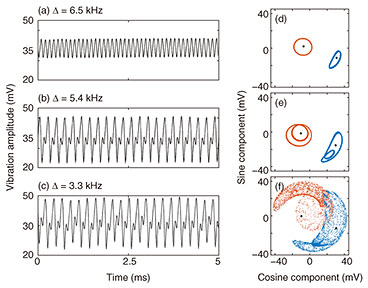 |
|||
|
|
|||
|
Short Reports Vol. 19, No. 3, pp. 74–77, Mar. 2021. https://doi.org/10.53829/ntr202103sr3 Demonstration of a Novel Method to Generate Chaotic Signals Using a MEMS Oscillator1. IntroductionNTT and Tokyo Institute of Technology have demonstrated for the first time a simple and generic method of generating chaotic signals using a microelectromechanical oscillator. Using chaotic signals in information technologies, such as machine learning and secure communications, has been extensively studied. It is important to develop an efficient method of generating chaotic signals using on-chip devices. A microelectromechanical systems (MEMS) oscillator is a promising device for this purpose and has advantages of high integration capability and precise electrical control. With our method, we succeeded in generating chaotic signals using the libration of a MEMS oscillator with one-order of magnitude lower voltage than previous methods. Our method also enables the integration of a chaos generator with standard MEMS devices, such as ultrasmall microphones and sensors. The method enables machine learning of the output data from these devices directly on a common semiconductor chip. The above results were obtained though the collaboration of NTT, where the device fabrication and measurement were conducted, with Tokyo Institute of Technology, where the data analysis was conducted on the basis of the theoretical calculations. The results were published in Physical Review Letters on October 23, 2020 [1]. 2. BackgroundChaos is a commonly observed phenomenon in various physical environments. Its temporal change looks apparently random, but also exhibits regular and deterministic behavior governed by simple laws of nature. There have been various studies on using the complex behavior of chaos in information technologies, such as machine learning, secure communications, and random-number generation. MEMS is a type of fine structure device that functionalizes the physical motion of the composing elements. MEMS is used in many practical systems such as high-performance sensors, high-frequency filters, and digital mirror devices. Producing chaotic signals using a MEMS oscillator was proposed some years ago as a promising technology for processing the output data from MEMS sensors, but this technology has not progressed due to the problem that chaos generation using standard MEMS technologies requires a large area of electrodes as well as high applied voltage up to several tens of volts. We propose a method for solving this problem by using libration of a MEMS oscillator. This method generates chaotic signals simply by applying two different frequencies of electric signals. The efficiency is so high that we do not need high voltage or large electrode structures; therefore, highly integrated devices with low operation voltage can be fabricated. 3. Device structure and achievementsThe MEMS device used in the demonstration consists of a suspended mechanical oscillator called a doubly clamped beam. The device was fabricated by processing a piezoelectric semiconductor, with which an alternate voltage is applied to induce mechanical vibration. We confirmed that the voltage including two frequencies generates libration, and aperiodic oscillation starts when the motion becomes large (Fig. 1). Theoretical analysis confirmed that the observed signal has the features expected for chaos. The voltage required to generate chaos was only a few volts, which is one order of magnitude smaller than with previous methods. We succeeded in generating chaotic signals with such small voltage using a simple beam structure.
4. OutlookThe frequency of mechanical vibration in this study is several megahertz, which is not high enough for practical applications. Therefore, we aim to generate chaotic signals at higher frequencies. After succeeding in fabricating such high-frequency devices, we will focus on practical applications of these devices such as for reservoir computation and secure communication. Reference
Researcher’s commentToward Emergent Computing
Ludovico Minati Nature does not work like a digital computer. The incredible complexity of the biological, social, and physical world is created by phenomena that follow simple rules. These rules are universal and nonlinear. They can produce many phenomena, including chaotic movements. Chaotic movements are irregular and can be synchronized in complex ways. Therefore, it is possible to generate complex patterns such as those found in the brain. These patterns can one day help generate and analyze information. Chaotic motion is usually generated using electronic circuits. Many types and components are possible and I have studied them. However, the characteristics of electronic components are not ideal, e.g., using a battery for a long time wastes energy and vibration resonance is not so sharp. Optical and mechanical devices fabricated on a nanoscale are far superior to transistors. In collaboration with NTT Basic Research Laboratories, we were able to develop a device that can generate chaotic mechanical vibrations very easily. Due to its very simple structure, many operations are possible. We will continue to collaborate to create a network of such devices. Researcher’s commentTowards Nanosystem-based Mechanical Brains
Samer Houri The fields of oscillator networks and network dynamics are currently witnessing astonishing progress both in terms of the theoretical understanding of such complex systems as well as their implementation in a variety of information processing applications such as artificial intelligence. The high computational load of conventional neural networks has prompted alternative designs of network-based information processing systems; among them is reservoir computation. In applications in which fast throughput and low power constraints are dominant, e.g., edge computing, the computationally heavy task of training a neural-network-based system is not acceptable; therefore, neural networks are replaced with nonlinear networks, i.e., a reservoir, the connections of which remain unmodified and the task of training is greatly simplified. Our research aims to create efficient reservoir-computation platforms using micro- and nanoelectromechanical systems (M/NEMS) as the infrastructure. MEMS and NEMS-based devices provide an excellent tool for the implementation of the highly nonlinear functions required for efficient reservoir computation. We recently demonstrated a path towards low-power generation of chaos and identified the region where the edge of chaos exists. The edge-of-chaos region is highly suitable at separating its inputs in a high-dimensional and abstract phase-space. Since such inputs represent information to be processed, the system is therefore capable of separating inputs into categories, such as distinguishing images or identifying patterns. We foresee exciting possibilities for the use of M/NEMS platforms for such applications, especially because they can be easily fabricated in large numbers to produce very high-dimensional reservoirs, and are able to react to external stimuli, thus combining both the functions of sensors and information processors. For inquiries:Public Relations, NTT Science and Core Technology Laboratory Group http://www.brl.ntt.co.jp/E/2020/10/latest_topics_202010241444.html |
|||











